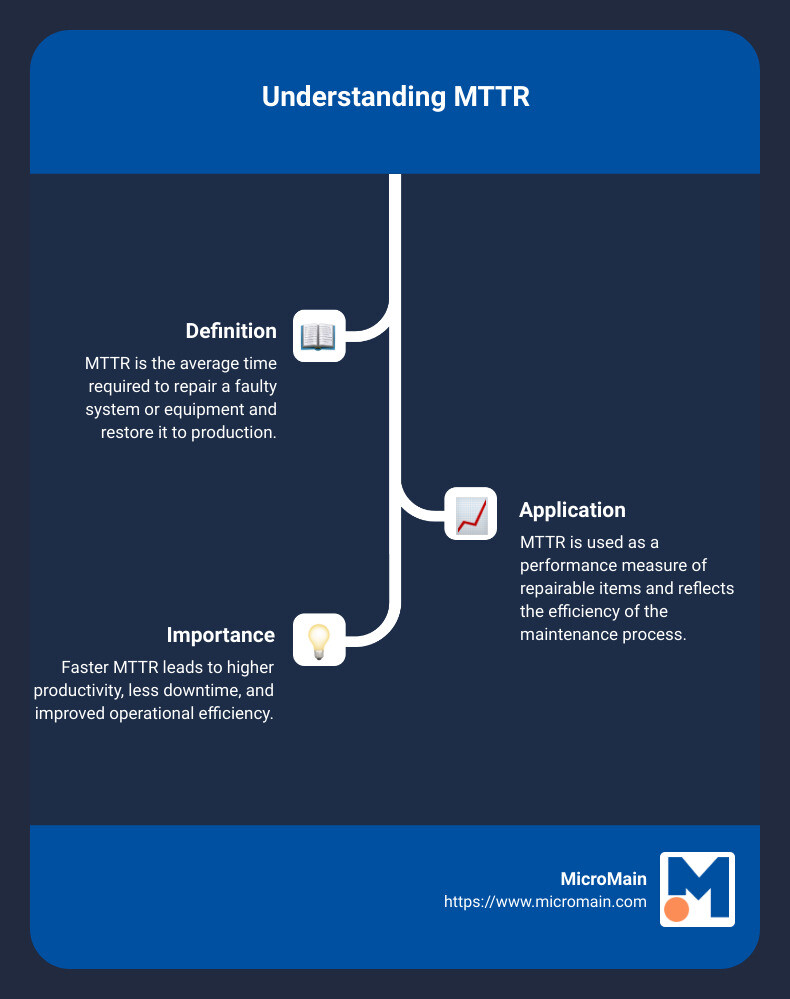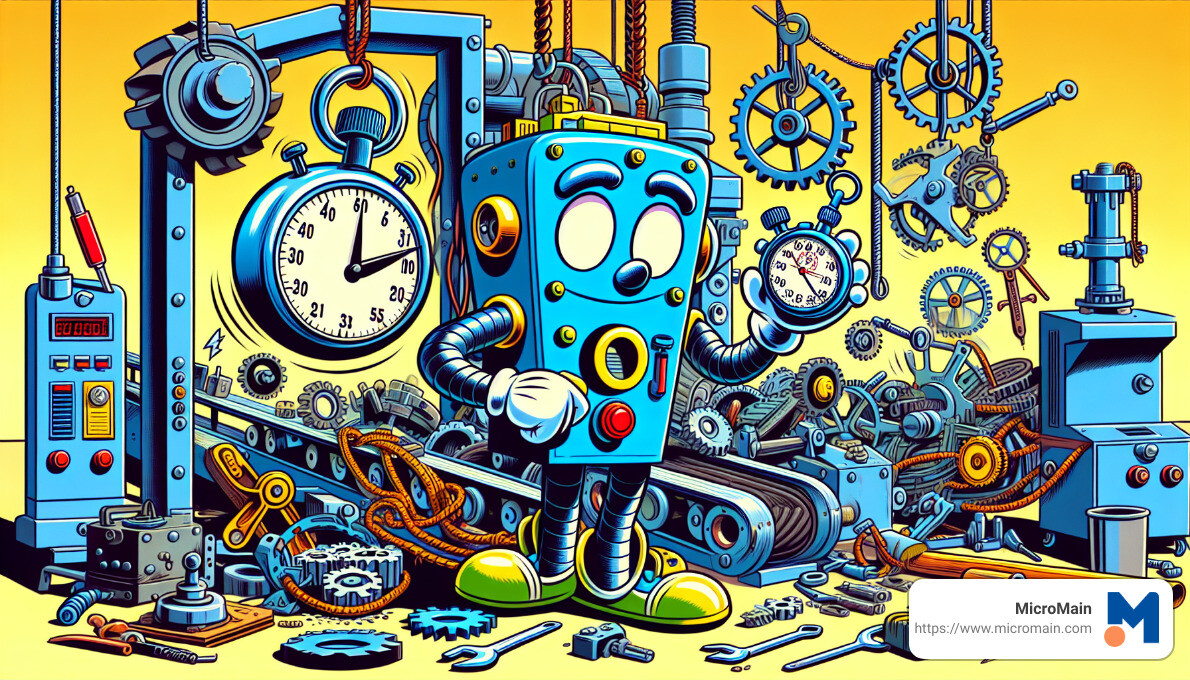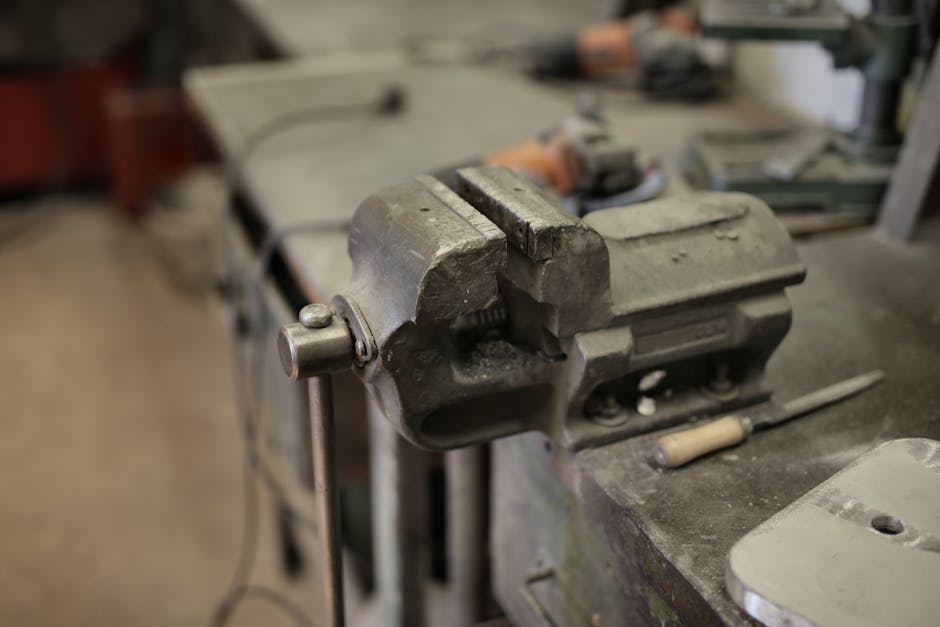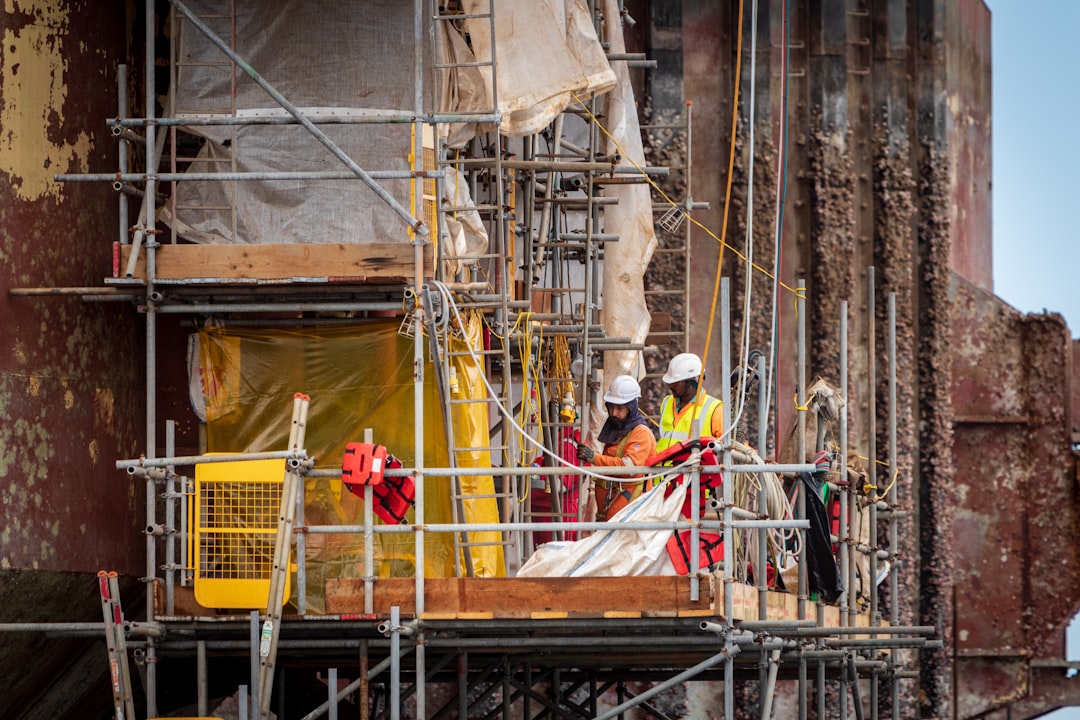Is your manufacturing plant facing frequent equipment downtime, inefficiencies, and high maintenance costs? At MicroMain, we understand how such issues can impact productivity and profitability. Having assisted countless manufacturing companies in optimizing their operations, we've seen the transformative power of a crucial maintenance metric many overlook the Mean Time to Repair or MTTR. This simple yet profound measure can be a secret weapon in enhancing your plant's efficiency and reliability.
MTTR represents the average time it takes to troubleshoot and repair a failed system or equipment, counted from the moment of failure to the point when it's back in action. A reduced MTTR equates to less downtime, sparking higher productivity and efficiency. But MTTR is more than just an abstract figure to strive to reduce. It reflects real-world repair processes, the skill of your technicians, and the effectiveness of your maintenance operations. A focus on lowering MTTR could be the solution to those costly, disruptive equipment failures you're grappling with.
To quickly comprehend MTTR:
- Definition: Mean Time to Repair (MTTR) is the average time required to repair a faulty system or equipment and restore it to production.
- Application: MTTR is used as a performance measure of repairable items and reflects the efficiency of the maintenance process.
- Importance: Faster MTTR leads to higher productivity, less downtime, and improved operational efficiency.
- Calculation: MTTR is the total corrective maintenance time divided by the total number of repairs in the same period.

In the following sections, we'll demystify MTTR further, guide you on its practical calculation, and offer strategies to improve it. Understanding and managing MTTR will herald a sea change in your maintenance operations. So, are you ready to tackle downtime and boost efficiency head-on? Let's dive in!
Defining MTTR: A Measure of Maintainability
To put it simply, the Mean Time to Repair (MTTR) is a crucial measure of how maintainable a specific item or system is. It signifies the average time to repair a failed component or device. In mathematical terms, it's the total corrective maintenance time divided by the total number of corrective maintenance actions for failures during a specific period.
It's essential to note that MTTR usually only includes the lead time for parts that are readily available or administrative or logistic downtime.
The Role of MTTR in Fault-Tolerant Design
In fault-tolerant design, MTTR takes on an even broader scope. It includes the time it takes to repair a fault and the time the fault is latent, meaning the time from when the failure occurs until it is detected. This is crucial because if a latent fault goes undetected until another failure occurs, the system might be unable to recover.
MTTR and Maintenance Contracts: Key Distinctions
When it comes to maintenance contracts, it's essential to clarify what exactly is meant by MTTR. Sometimes, it's a measure of the mean time from the point of detection of the failure until the equipment is back up and running. This is often termed "mean time to recovery." However, it could also measure the elapsed time from when the repairs begin until the equipment is operational, usually termed "mean time to repair."
For instance, a system with a service contract guaranteeing an MTTR of 24 hours might seem more attractive than one with a service contract guaranteeing an MTTR of 7 days. However, if the 24-hour MTTR doesn't account for additional time for part lead times, administrative delays, and technician transportation delays, which add up to an average of 6 days, then it would only be as attractive as the system with a 7-day MTTR.
Understanding MTTR is not just about knowing the definition; it's about grasping its applications and implications in different contexts. At MicroMain, we believe in empowering our customers with the knowledge and tools to accurately calculate and effectively manage MTTR, leading to more efficient maintenance operations and, ultimately, higher equipment availability.
Calculating MTTR: A Step-by-Step Guide
To truly understand the 'Mean Time To Repair' (MTTR), you must know how to calculate it. This metric gives you an average of how long it takes to repair a system or piece of equipment once it has failed. It's a critical tool for assessing the efficiency of your maintenance operations.
Understanding the MTTR Formula
The MTTR formula is straightforward: the total maintenance time divided by the number of repairs. For instance, if you've spent 50 hours on unplanned maintenance for equipment broken down eight times a year, the MTTR would be 6.25 hours (50 hours ÷ 8 repairs).

The formula assumes that tasks are performed sequentially by appropriately trained personnel. However, it's important to note that the MTTR doesn't include the waiting period for replacement parts. That is, it only covers when a failure is detected until the equipment is operational again.
The Importance of Removing Outliers in MTTR Calculation
While calculating MTTR, consider and remove outliers. These are unusually long repair times that can skew your average. Ignoring them can misrepresent your typical repair time, making your MTTR higher than it is.
Removing outliers gives you a more accurate picture of your average repair time, enabling you to make more informed decisions about your maintenance processes.
Using CMMS Software for Automated MTTR Calculation
At MicroMain, we understand that manually calculating MTTR can be time-consuming. We've integrated automated MTTR calculation into our Computerized Maintenance Management System (CMMS) software.
Once you've entered the necessary data, our CMMS software automatically calculates the MTTR. This saves you time and eliminates the risk of human error in your calculations. Moreover, it allows you to track MTTR over time, helping you identify trends, pinpoint issues, and make necessary improvements.
In conclusion, understanding the MTTR formula, removing outliers, and leveraging technology for automation are essential steps in accurately calculating and effectively managing MTTR. As a result, you'll gain a clearer picture of your maintenance efficiency, enabling you to make data-driven decisions that can enhance your operations.
The Impact of MTTR on Maintenance Operations
Understanding the Mean Time to Repair (MTTR) goes beyond just a simple calculation. It carries significant implications for the entire maintenance operation. This includes its effect on operational availability, its role as a baseline for enhancing efficiency, and its crucial part in decision-making processes such as whether to repair or replace a piece of equipment.
How MTTR Affects Operational Availability
The primary aim of any maintenance operation is to maximize equipment uptime. This ensures that operations can continue smoothly with minimal disruption. MTTR directly impacts this goal. A longer MTTR indicates a more extended downtime, which can lead to production halts and financial losses. By minimizing MTTR, we can maximize operational availability.
Reduction in MTTR is achieved by identifying and addressing factors that prolong repair times. This could range from inefficient maintenance procedures to inadequate resource allocation. Understanding MTTR allows us to make informed decisions about these factors, increasing uptime and productivity.
MTTR as a Baseline for Increasing Efficiency
MTTR is a key performance indicator (KPI) against which we can benchmark our maintenance performance. Monitoring MTTR can identify inefficiencies in our maintenance processes and areas that need improvement.
For instance, if a piece of equipment consistently has a high MTTR, it might suggest that it requires more technicians or specialized tools. This understanding can allocate resources more effectively, reducing MTTR and increasing maintenance efficiency.
The Role of MTTR in Decision Making: Repair or Replace?
An increasing MTTR for aging assets can signify that replacement is a more cost-effective approach than continual repairs. This is where MTTR becomes critical in deciding whether to repair or replace equipment.
By providing insights into the lifecycle costs of systems, MTTR can guide procurement and design strategies. For example, if the MTTR is rising for a particular asset, replacing it with a new one with a lower MTTR might be more economical.
At MicroMain, we understand the significant role that MTTR plays in maintenance operations. Our CMMS software is designed to help you calculate and manage MTTR effectively, providing the data you need to make intelligent, cost-effective decisions. By leveraging the power of MTTR, you can optimize your maintenance operations, resulting in cost savings and improved productivity.
Strategies to Improve MTTR
In maintenance operations, 'mean time to repair' (MTTR) isn't just a number on a spreadsheet - it's a critical metric that can reveal the strengths and weaknesses of your processes. However, to make the most of MTTR, you must actively work on strategies to improve it.
Benchmarking MTTR Against Best-in-Class Facilities
One way to gauge your facility's MTTR performance is to benchmark against industry leaders. This gives you a valuable frame of reference, helping you understand where your maintenance processes stand compared to the best in the business. It also reveals potential areas for improvement and gives you a goal to strive towards.
Standardizing and Fine-Tuning Processes to Reduce MTTR
One of the most effective ways to improve MTTR is to standardize and fine-tune your maintenance processes. A detailed, well-structured process can significantly reduce the time it takes to repair an asset.
For example, operators should know precisely how to fill out a work order, with a precise template ensuring consistent information. Technicians should have a thorough task list for repairs, including exact specs or measurements. By looking at these elements and fine-tuning them, you can create standard instructions that lead to consistent quality of work and anticipated results.
Leveraging Modern Technology to Optimize the Repair Process
Technology can play a significant role in optimizing the repair process and reducing MTTR. At MicroMain, we understand the importance of making resources more readily available to technicians. That's why we've made it possible to digitize all your asset histories, manuals, SOPs, diagrams, and other vital documents, making them easily accessible through a mobile device.
This eliminates the time wasted searching for physical files and ensures that technicians have all the necessary information at their fingertips. This way, repairs can be done more quickly, and MTTR can be reduced.
The goal is to transform your facility's MTTR from just a metric to a tool for continuous improvement. By benchmarking against industry leaders, standardizing your processes, and leveraging modern technology, you can significantly improve your MTTR, leading to less downtime, increased efficiency, and cost savings. Our next section will discuss the differences and relationships between MTTR and other essential maintenance metrics.
MTTR vs. Other Key Maintenance Metrics
When managing maintenance operations, it's crucial to understand that MTTR (Mean Time To Repair) is not the only metric that matters. Key performance indicators (KPIs), such as Mean Time to Recovery and Mean Time Between Failure (MTBF), also play a significant role. Let's delve into these metrics and ascertain how they differ from MTTR and how they interact with each other.
Distinguishing Between MTTR and Mean Time to Recovery
While both MTTR and Mean Time to Recovery can be used to measure the duration of downtime, they have distinct definitions and applications. MTTR, as we've discussed, represents the average time it takes to repair a failed system or equipment. This includes the time taken to diagnose the problem, fix it, and validate the repair.
On the other hand, Mean Time to Recovery includes the repair time and any additional time taken to recover and restore the system to its normal operational state. This could involve rebooting systems, reloading data, or any other activities necessary to return the system online.
Hence, while both metrics provide valuable insights into system downtime, they focus on slightly different aspects. MTTR focuses more on the maintenance process, while Mean Time to Recovery considers the full recovery process, offering a more holistic view of system downtime.
Understanding the Relationship Between MTTR and Mean Time Between Failure (MTBF)
MTBF and MTTR are crucial metrics in maintenance management, but they serve different purposes. While MTTR measures the efficiency of the repair process, MTBF evaluates the reliability of a system or device.
MTBF (Mean Time Between Failures) is the average time a system operates without failure. A high MTBF indicates that a device is dependable and likely to operate for a more extended period before experiencing a failure.
Therefore, understanding the relationship between MTTR and MTBF is crucial in creating a comprehensive maintenance strategy. For instance, if your MTBF is high and MTTR is low, it signals that your maintenance operations are highly efficient, leading to less downtime and higher productivity.
At MicroMain, we understand the importance of these metrics and how they can drive improvements in your maintenance operations. Our powerful CMMS software can help you track and analyze these key metrics, providing valuable insights to boost operational efficiency and reliability.
The Role of MicroMain's CMMS in MTTR Management
Understanding and managing the mean time to repair (MTTR) is essential for efficient maintenance operations. At MicroMain, we offer a comprehensive CMMS tailored to help you manage this critical metric effectively.
How MicroMain's CMMS Automates MTTR Calculation
Calculating MTTR manually can be a time-consuming and error-prone process. Luckily, our CMMS automates this task, saving you time and ensuring accuracy. It systematically tracks the unplanned downtime associated with breakdowns and records the date and time when a piece of equipment is reported inactive for repair purposes. It then calculates the time to restore the asset to its normal operating condition, providing you with the MTTR metric.
Our software maintains a comprehensive maintenance log for each asset, offering a holistic view of your maintenance operations. This lets you quickly identify trends and improvement areas, helping you optimize your strategies, reduce breakdowns, and minimize downtime.
Using MicroMain's CMMS to Streamline the Repair Process and Improve MTTR
One of the most effective ways to reduce MTTR is to streamline the repair process. Our CMMS can support this with its work order management system. This feature allows maintenance teams to track work orders, spare parts inventory, and preventive maintenance schedules all in one place, speeding up decision-making and the repair process.
Our CMMS also supports predictive maintenance strategies. By leveraging sensors and analytics, it can forecast when equipment will fail, enabling teams to address potential issues before they become severe. This proactive approach can reduce repair time by preventing unexpected breakdowns, thus improving your MTTR.
Furthermore, our software aids in MRO inventory management. Our CMMS helps you avoid such scenarios by accurately forecasting the parts needed for imminent tasks, including unplanned ones, thereby reducing repair times.
In conclusion, MicroMain's CMMS plays a crucial role in managing MTTR. It not only automates the calculation of this vital metric but also provides tools and strategies to streamline the repair process and reduce downtime. By leveraging our software, you can significantly improve your maintenance operations and focus on what you do best: producing and marketing your products.
Conclusion: The Importance of Understanding and Managing MTTR
Understanding and managing Mean Time to Repair (MTTR) is not just about numbers and calculations. It's about harnessing a crucial metric that can streamline your maintenance operations, reduce downtime, and ultimately drive your organization's productivity and profitability.
MTTR provides a clear snapshot of how swiftly your maintenance team can respond to and rectify issues, ensuring your systems return to production as swiftly as possible. It is a crucial indicator of the effectiveness of your maintenance processes, helping you to identify potential bottlenecks and areas for improvement. It also serves as a critical parameter in making informed decisions, such as repairing or replacing an asset.
Improving MTTR can be achieved by standardizing and fine-tuning processes, making necessary resources more available, and using failure codes for faster problem diagnosis. It's about creating a responsive, efficient maintenance system that keeps your operations running smoothly and maximizes the lifespan of your assets.
Here at MicroMain, we understand the importance of managing MTTR effectively. Our CMMS solutions are designed to automate MTTR calculation, provide actionable insights, and offer strategies to optimize the repair process. We help you turn potential weaknesses into strengths, leading to reduced downtime and increased efficiency.
In the end, understanding and effectively managing MTTR is a crucial aspect of maintenance management. It contributes to operational efficiency and positively impacts the bottom line. By leveraging metrics like MTTR, you can ensure your maintenance operations are reactive and proactive, contributing to your organization's overall success and growth.
For more information on improving your maintenance operations, check out our preventive maintenance and optimization resources.
Time matters in maintenance. Make every second count. Keep pushing for improvement. Keep striving for efficiency. And let MTTR be your guide.
All of us at MicroMain wish you success in your maintenance journey. We're here to help every step of the way.
 For immediate assistance, please call us at (512) 328-3235
For immediate assistance, please call us at (512) 328-3235




